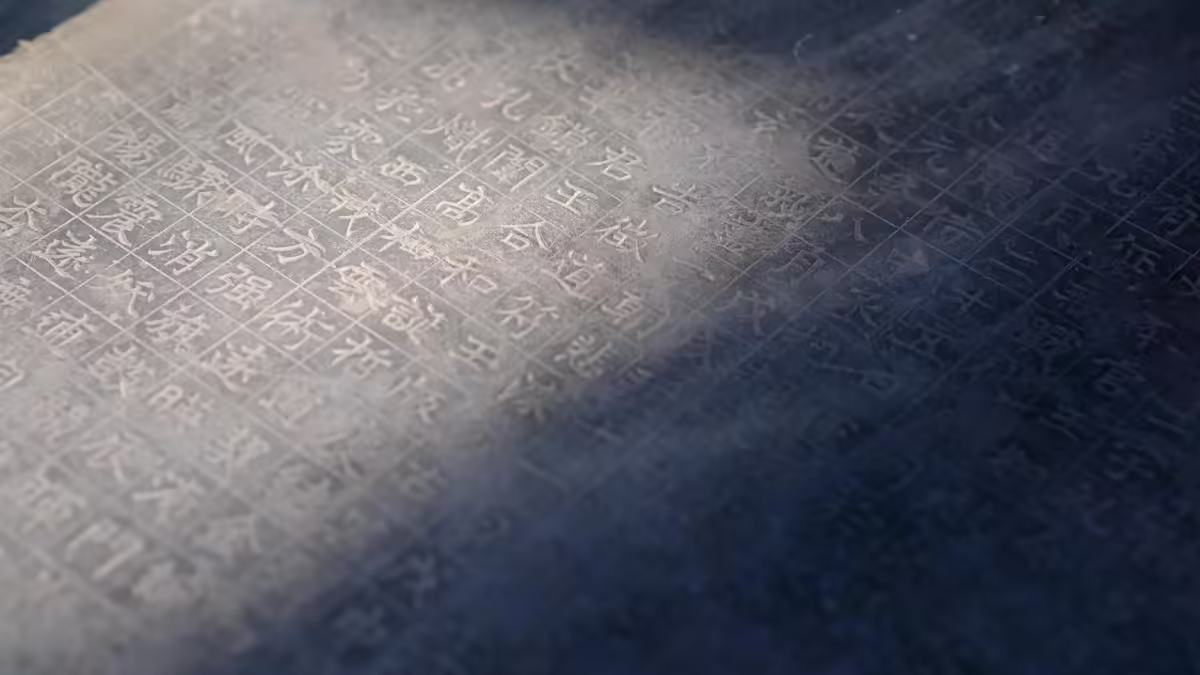For enthusiasts of calligraphy and stone carving, the Xi’an Stele Forest Museum is an essential destination. Originally established as the Shaanxi Provincial Museum in 1944, the Stele Forest itself dates back to the Northern Song Dynasty, Year 2 of the Yuanyou Era (1087 AD). It is one of the earliest and largest repositories of ancient stone inscriptions in China. The museum houses a collection of over a thousand stone tablets and tombstones spanning from the Han to the Qing Dynasties. Due to the dense concentration of these stones, it is aptly named the “Stele Forest.”
Travel Information about Stele Forest Museum
Ticket Prices and Opening Hours
Ticket Prices: Off-season (December to February) ¥50; Peak season (March to November) ¥75.
Opening Hours: Off-season: 8:00 AM – 6:30 PM; Peak season: 8:00 AM – 7:00 PM.
How to Get There
Location: No. 15, Sanxue Street, Beilin District, Xi’an; within the South City Wall’s Wenchang Gate.
Metro: Take Line 2 to Yongningmen Station and walk to the museum.
Attraction Ratings
- Cultural Significance: ★★★★★
- Special Features: ★★★★★
- Leisure: ★★★★
- Beauty: ★★
- Romance: ★★★
- Excitement: ★
Highlights of Stele Forest Museum
Stele Forest
The Stele Forest was initially established by Lü Dazhong and others during the Northern Song Dynasty to preserve famous Tang Dynasty stone inscriptions such as the “Shitai Xiaojing” and the “Kaicheng Stone Classics,” as well as notable calligraphic works by masters like Yan Zhenqing and Liu Gongquan, which had been abandoned in the chaos of the late Tang and Five Dynasties.
Rich in content, the Stele Forest is both a treasure trove of ancient Chinese calligraphy and a repository of historical documents and stone carvings. It records significant achievements in Chinese cultural development and reflects the historical exchange between Chinese and foreign cultures, earning it fame both domestically and internationally.
The Stele Forest Museum, built upon the original site of the ancient Stele Forest, has been expanded using the architectural complex of the Xi’an Confucian Temple. It comprises three sections: the Confucian Temple, the Stele Forest, and the Stone Carving Art Gallery. The museum’s collection includes over 4,000 steles and tombstones dating from the Han Dynasty to the present, spanning more than 2,000 years. Its extensive collection and the variety of dynasties represented are unparalleled in China. The dense array of steles features inscriptions in seal, clerical, regular, running, and cursive scripts, showcasing a stunning array of masterpieces by renowned calligraphers.
Related Details:
- “Kaicheng Stone Classics”: This is the most complete set of stone-carved books in China. Created during the second year of the Kaicheng era (837 AD) of the Tang Dynasty under Emperor Wenzong, it consists of twelve volumes, with a total of 114 stelae and 228 surfaces, inscribed with 650,252 characters. These texts were essential reading for scholars in feudal Chinese society and are named “Kaicheng Stone Classics” because they were carved during the Kaicheng era.
- “Shitai Xiaojing”: Known for its grand scale, this stele stands nearly 6 meters tall and is topped with a double-layered ornate crown carved with swirling clouds. The base features a three-tiered stone platform adorned with carved lions and vines. The main body of the stele is composed of four large stones, engraved with the “孝经Xiaojing” (Classic of Filial Piety) written by Emperor Xuanzong of the Tang Dynasty, Li Longji, in clerical script during the Tianbao era (745 AD), along with his personal annotations and preface to the text.
Confucian Temple
The new Stone Carving Art Museum of the Stele Forest, known as the Confucian Temple, was originally established during the Tang Dynasty. It preserves numerous architectural structures from the Ming and Qing dynasties and is now a key national cultural heritage site, also serving as the location for the new Stone Carving Art Museum.
The Confucian Temple not only maintains the complete layout of ancient academies, but also features seven Qing Dynasty stele pavilions along the central axis of the Stele Forest. Each pavilion houses a large stele inscribed with both Manchu and Han characters, commemorating the achievements of the Qing emperors Kangxi, Yongzheng, and Qianlong.
Stone Carving Art Room
The Xi’an Stele Forest Stone Carving Art Room, located on the east side of the Xi’an Stele Forest Museum, was established in 1963. The plaque was inscribed by Marshal Chen Yi. In 2010, a new stone carving art museum was opened within the Xi’an Stele Forest Museum. This museum features collections primarily from the Han Dynasty to the Ming and Qing Dynasties, showcasing tombstone carvings.
Highlights include the Eastern Han Double Beasts, Han Dynasty Image Brick Stones, Tang Dynasty Li Shou’s Stone Coffin and Epitaphs, and the Six Steeds of Zhao Ling. The collection is renowned for its diverse carving techniques and styles, representing exquisite examples of stone carving art from different historical periods.
The new stone carving art museum also includes a multimedia interactive section where visitors can engage with the Stele Forest through various formats such as simulated statues, virtual book flipping, electronic rubbings, and 3D magical books.
Stone Carving Art Museum
The Stone Carving Art Museum features the exhibition theme “The Buddhist Charm of Chang’an” and displays approximately 150 stone carvings from the Northern Wei to the Song Dynasty. This exhibition represents the pinnacle of Buddhist art in historical Chang’an.
The exhibit is divided into three main areas: the Stele Carving Zone, the Image Zone, and the Large-Scale Image Zone. The collection primarily consists of stone carvings, including both standalone statues and those with inscriptions. Highlights include colossal standing statues of Buddhas and Bodhisattvas, intricately carved backscreen images, delicately designed niche sculptures, and numerous exquisite but fragmented Buddha and Bodhisattva heads.
While visiting the Stele Forest Museum, you can also explore the nearby cultural street to purchase culturally themed souvenirs. Options include replicas of Sui-Tang Buddha heads, stele rubbings from the museum, complete rubbings of Su Shi’s original works, and other gifts like Wangzhuang products.

